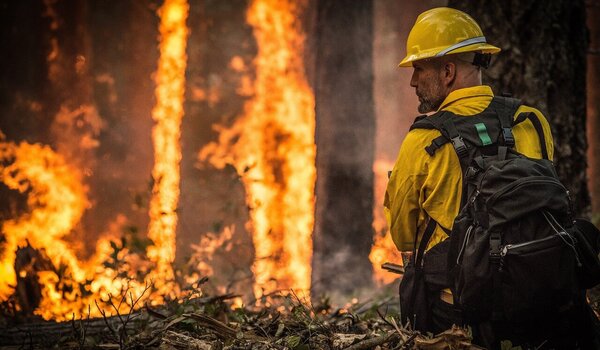The 2022 wildfire season is off to a ferocious start, with fires raging from California to Alaska. It’s a foreshadowing of what promises to be another record-breaking fire season in the United States. Last month, approximately 2 million acres burned. And major fires are currently raging in Idaho, Utah, and California, threatening the homes and livelihoods of tens of thousands of Americans.
According to new University of Georgia research, many of those at risk are lower-income Americans who face canceled homeowners insurance policies and rising premiums. The study, published in Forests, discovered that counties with moderate-to-high wildfire risk are more likely to have higher poverty rates. Many of these counties are in states dominated by a few insurance companies. Homeowners’ options in these areas may be limited if they need to replace a policy that has been terminated.
“The overlap of wildfire risk, poverty, and concentrated insurance markets should get people thinking about policies and interventions to help the most vulnerable homeowners,” said Matthew Auer, lead author of the study and dean of the School of Public and International Affairs.
The data from the First Street Foundation should give everyone pause because it shows entire states with comparatively high wildfire risk. States we don’t typically think of as being particularly vulnerable to destructive wildfires, such as Nebraska and Oklahoma, are in jeopardy.
Matthew Auer
More counties, states likely at risk of fires than previously thought
By comparing average annual acres burned between 2016 and 2020, Auer and graduate student Benjamin Hexamer identified the 14 states in the lower 48 with the highest wildfire risk in the United States. Arizona, California, Colorado, Florida, Idaho, Montana, Nevada, New Mexico, Oklahoma, Oregon, Texas, Utah, Washington, and Wyoming are among them.
The study discovered that 98 counties in those states had a high wildfire hazard potential. Oklahoma and Wyoming were the only states without a high-risk county. According to U.S. Census Bureau data, approximately 60% of the high-risk counties in the remaining 12 states were designated as higher poverty.
The researchers also discovered discrepancies between the data from the US Forest Service on which counties are at high risk of wildfires and the number of counties deemed at risk by the First Street Foundation, a nonprofit that provides a national, peer-reviewed wildfire risk model for properties in the lower 48.
“The data from the First Street Foundation should give everyone pause because it shows entire states with comparatively high wildfire risk,” Auer said. “States we don’t typically think of as being particularly vulnerable to destructive wildfires, such as Nebraska and Oklahoma, are in jeopardy.”
“None of us, really, in this day and age can be blasé about wildfire risk.”

Protecting against wildfires may require government intervention in insurance industry
Many commercial insurers are fleeing wildfire-prone areas, reducing the competition that has historically kept premiums reasonable.
Those that remain in the market are not only raising their prices, but also frequently reducing the scope of their policies. They’re also requiring homeowners to take fire safety precautions, such as clearing landscaping and brush away from their homes to slow the spread of a potential fire. That is feasible in wealthier counties, where incomes are high and homeowners can afford higher premiums or even rebuild their homes entirely if necessary. For others, however, those changes add up.
“For folks who are in poorer counties, homeowners don’t have as much flexibility, and they don’t have the ability to afford all of the wildfire prevention strategies that may be required by the few companies willing to insure homes in wildfire-prone areas,” Auer said. “This issue hasn’t been addressed in some states, and it needs to be because the situation we see today is just going to get worse.”
California policies provide blueprint for safeguarding against insurance mass exodus
In California, the state has stepped in to prevent insurance companies from not renewing policies in areas affected by catastrophic wildfire. The commissioner also created a program called Safer from Wildfires, which incentivizes homeowners to make fire-protective upgrades and encourages insurers to come back to the market.
California homeowners who find themselves without many insurance options frequently have to settle for “insurance of last resort.” The premiums are high, and the policies are limited in scope. Policyholders may also be required to take precautionary measures to reduce the risk of fire damage to their homes.
However, it is preferable to nothing. Auer believes that other high-risk states will likely follow California’s lead, and that wildfire risk is a bipartisan issue. “Wildfire isn’t concerned with party affiliation,” he explained. “Our houses are not Republican or Democratic. They are simply homes in the path of wildfire.”
















